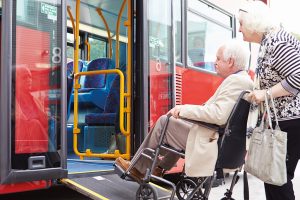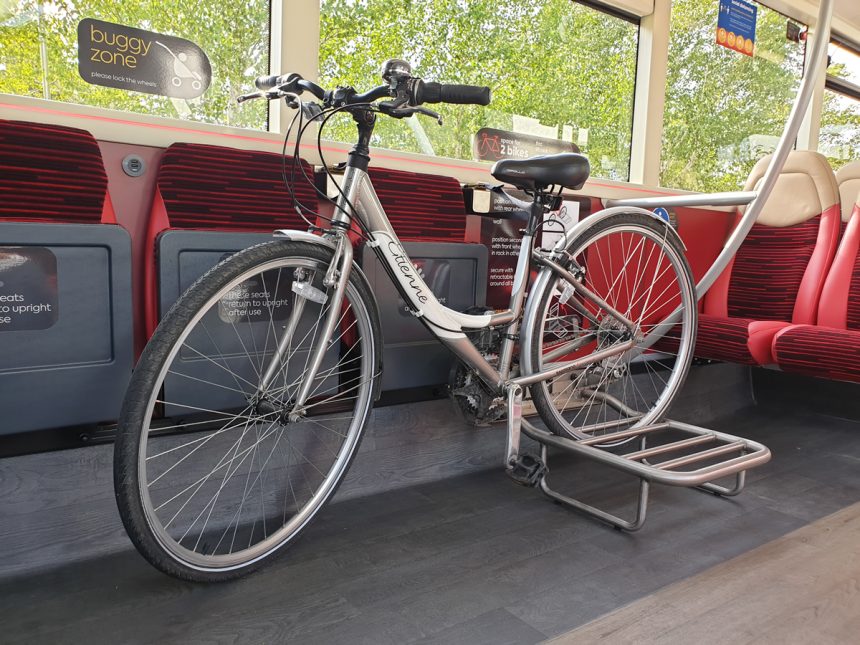Disability access is a well-known issue for operators, but we also touch on two lesser-considered types of bus users — cyclists and dog owners
Any successful business appreciates that denying your product to a section of the market is to be avoided. The same principle applies to the bus industry, which has experienced a shrinking customer base over the past generation.
Here we look at three disparate areas which coach and bus operators consider when making services more open to all. While operators are very conscious of the need to make services accessible to those with disabilities — for both regulatory and business reasons — the ideas of carrying bikes and dogs on buses are much less considered.
Disability issues
The issue of accessibility for those with a disability might appear to be a bigger one for the coach sector with 99% of local bus services compliant with Public Service Vehicle Accessibility Regulations (PSVAR), but there remain considerations for bus operators in trying to avoid alienating a segment of the potential market.
Bus Users UK, in responding to the government’s call for evidence this year on PSVAR, requested an overhaul of the regulations with respect to both coach and bus. Among that, in connection with wheelchair users, was a reversal of the bay so the passenger is facing forwards, attention to problems with some wheelchairs boarding buses, changes regarding bay priority, and simplifying assistance requests of the driver.

The charity’s Chief Executive Officer, Claire Walters, stresses her response was more of a “wish-list” than a realistic expectation but adds that operators should consider passenger needs more carefully when buying buses. “One of the things I’ve been banging on about since I joined this organisation 13 years ago is that the people who get sent to buy the buses are generally the Finance Director and the Engineering Director. Nobody that knows anything about passengers or disability tends to have a say until way down the line. They are retail environments. I can’t imagine you’d have M&S going out with just the maintenance person and the finance person to pick the new line in offerings to customers.”
On the issue with boarding, she says: “To push up a steep incline requires more strength than some companions have. The bus driver is not really supposed to get out of the bus and push. One of the issues we’ve had is quite a lot of electric ramps breaking down, so a lot of companies have gone back to using manual.”
Wheelchairs and their design move on apace, much quicker than bus design can – Claire Walters
She also highlights the lack of an adequate turning circle on the bus sometimes. “Wheelchairs are getting bigger because the population’s getting bigger,” she says. “Wheelchairs and their design move on apace, much quicker than bus design can, and the bus will last 10-15 years.” She admits that operators have a difficult balancing act to carry out when it comes to allocating space onboard.
Another aspect to consider should be neurodiversity-sensitive flooring. Claire adds: “Most of the people who design and build buses should know by now that putting a very dark flooring in a vehicle like that will cause some people with dementia, quite a lot of people with autism and various people with ADHD to think they’re falling into a big black hole.
“If you’ve got flooring that operators want to be brand-friendly, quite often that will result in quite a dark tone and it’ll be easy to clean. But it’s really not very passenger-friendly. Quite often the easiest thing to do is to give people something that looks a bit like floorboards and nobody tends to get upset by that. The brighter or darker or more jazzy you go, the more problems you’re likely to have.”
Bikes on buses
If a passenger wants to take a non-foldable bike on to a bus in the UK, options are very limited due to the obvious safety, comfort and space concerns.
However, being able to carry bikes on board may lead to extra fare revenue, while there are also longer-term benefits for the industry in encouraging active travel and making alternatives to the car more attractive.
The National Bus Strategy’s Bus Back Better document (2021) alluded to another government report, Gear Change (2020) on the vision for walking and biking. The latter stated: “We will carry bikes on more bus routes.” It added: “Buses and cycles can also work together, allowing journeys which are otherwise only possible by car… In many rural areas, where demand is lower, we will work with bus operators to allow a limited number of bikes on board.”
However, Border Buses and Go North East are two of the very few bus companies that have bike racks installed on some services. Go North East, which has used these racks on five routes since 2020, says: “We continue to consider this feature on each new vehicle order, subject to confirmation in a consultation that customers on these routes would find it beneficial.”
Go North East says it assisted Transport North East with its “North East Active Travel Strategy”, which had the target of a increasing active travel journeys. It adds: “By carrying bikes on buses, we can encourage more people to combine active travel with public transport.”
However, it adds: “The biggest challenges we face are around ensuring the carriage of a bicycle does not delay journeys and inconvenience customers.”
It is for this reason that some have proposed bike racks on either the front or back of the buses.

The United States is not the first country you would associate with active travel, but such exterior racks have been widely used there for decades. As many as 90% of buses have them, according to specialist supplier Sportworks. Costing roughly $1,200-2,000, they allow up to three bikes to be carried and they are seemingly so popular that an increasing number of operators are now installing internal racks too to accommodate the bikes.
Such racks were heavily promoted in the UK until his recent death by Peter Davenport, the late Managing Director of cycle parking and shelter company Cycle Works. James Baldwin, his successor at the helm of the business, says: “This was Peter’s driving passion. He was always coming up against issues with the Department for Transport.
“Multi-modal is a bit of a buzzword now and bikes on buses is what you need to bring it all together. It would encourage people to ride a bike and get out of the car. If putting it on the front of a bus makes it easier to cover some of your journey, maybe if it rains, it gives you more options and it makes it more appealing to do more cycling.”
That said, Claire reveals that allowing bikes on buses has not been an issue that Bus Users UK regularly hears about. She adds: “It’s a massive investment to have a bus that’s built for taking bikes. It’s never going to be something that’s going to be added onto every bus.”
DfT tells us it would encourage bus operators to consider policies to carry bicycles where possible. However, with regards to external racks, it refers to the Road Vehicles (Construction and Use) Regulations 1986 covering maximum overall length, turning circle, adequate view of the road ahead and the avoidance of danger, and the Road Vehicles Lighting Regulations 1989 covering visibility of position lamps and indicators and the use of additional lamps for projecting loads.
Multi-modal is a bit of a buzzword now and bikes on buses is what you need to bring it all together – James Baldwin
However, April Johnson, Vice President of Sales and Marketing at Sportworks, says: “There are no safety concerns regarding it here.” She says that when designing a rack for a new model of bus, they do a test fit to ensure there is no impact on headlights, visibility, windscreen wipers and turning circle.
Transport for London says putting bike mounts on the front of buses wouldn’t meet with its Bus Safety Standard and that onboard racks would impact load times and capacity.
Bike racks at the rear, as seen on Arriva’s Nottingham Hopper buses, may be seen as safer for other road users but the drawback seems to be the possibility of cyclists losing their bikes — either due to theft or the driver moving away before the passenger has had chance to retrieve it. Arriva tells us they are not used much on the Nottingham service.
Could buses be more dog-friendly?
Dogs are permitted on most buses although, when it comes to those which are not assistance animals, it is often at driver discretion, for example depending on the behaviour of the animal and whether other pets are on board.
The need for such an approach is understood, although some potential passengers could be put off by the uncertainty of whether they will be allowed to board and the potential for an uncomfortable encounter with the driver.

With The Kennel Club’s research showing 45% of dog owners are more likely to travel on public transport because of dog friendly policies, its website encourages operators to make their policies unambiguous. It notes this includes good up-to-date website information and considering using the organisation’s “open for dogs” sticker.
Bill Lambert, spokesperson for The Kennel Club, says: “Our research shows that nearly two thirds of dog owners think that dog-friendly public transport makes their journeys easier. For those living in areas where driving or walking may not be possible or accessible, it can be a huge benefit to ensure public transport is available for all dog owners.”
Claire, though, believes that dog owners do not usually encounter problems. “If it’s a regular thing and the same dog all the time, it’s generally not a big issue because the dog will have proved itself to be well behaved on a bus,” she says. “If you’ve got a dog and a regular journey to make, often an approach to the depot manager is all you need. They can issue a letter and you can show that to the driver. As long as the dog behaves itself and doesn’t disgrace itself in any way, that should continue.”



























